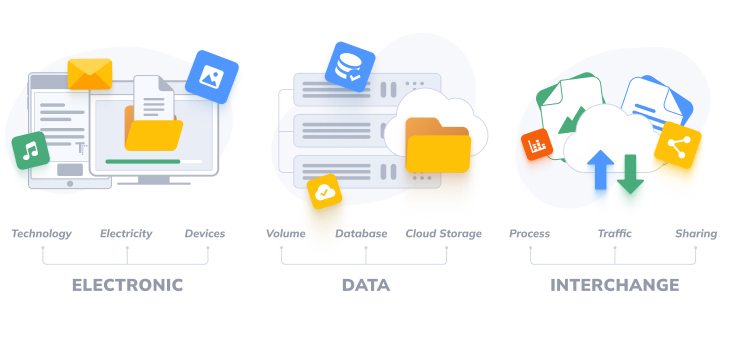
In today's interconnected global economy, businesses thrive on efficient communication and seamless transactions with their partners. The sheer volume of documents exchanged daily – purchase orders, invoices, shipping notices, inventory updates – can be overwhelming if handled manually. Traditional methods involving paper, fax, or even email attachments are slow, prone to errors, costly, and lack the real-time visibility modern supply chains demand. This is where Electronic Data Interchange (EDI) becomes crucial.
But simply using EDI isn't enough to unlock its full potential. Effectively leveraging this technology requires a strategic approach known as EDI management. It's the difference between having a powerful tool and knowing how to wield it expertly to drive significant business improvements.
This article provides a deep dive into EDI management: what it entails, the fundamental EDI concepts it builds upon, the transformative benefits it offers companies, common challenges it addresses, and how partnering with experts can streamline the entire process.
Understanding EDI Fundamentals: The Building Blocks
Before exploring management, let's quickly recap what EDI is. Electronic Data Interchange (EDI) is the computer-to-computer exchange of business documents in a standard electronic format between business partners. Instead of printing an invoice and mailing it, your system sends the invoice data directly to your partner's system electronically.
Key components make this possible:
- Standard Formats: For computers to understand each other, they need a common language. EDI standards define the precise structure and content of electronic documents. Major standards include:
- ANSI X12: Widely used in North America across various industries.
- EDIFACT: The international standard developed under the United Nations, common globally.
- TRADACOMS: Primarily used in the UK retail sector.
- HIPAA: Specific EDI standards mandated for the US healthcare industry (a subset of X12).
- Others like ODETTE (automotive), RosettaNet (high-tech), etc.
- Translation & Mapping Software: Businesses rarely store data internally in perfect EDI format. Translation software converts data from internal application formats (like those used by ERP, accounting, or warehouse management systems) into the required standard EDI format for transmission. Conversely, it translates incoming EDI documents into a format your internal systems can understand. Mapping defines how specific data fields in your system correspond to fields in the EDI standard. Accurate mapping is critical.
- Communication Protocols: These are the secure methods used to transmit EDI documents between partners. Common options include:
- Value-Added Networks (VANs): Secure, private networks acting like a mailbox service for EDI documents.
- AS2 (Applicability Statement 2): A highly secure, internet-based protocol offering encryption and digital receipts (MDNs).
- FTP/SFTP/FTPS: File Transfer Protocol methods, with SFTP and FTPS providing secure, encrypted file transfer over the internet.
- APIs (Application Programming Interfaces): Increasingly used for real-time, direct application-to-application data exchange, sometimes alongside or instead of traditional EDI.
- Trading Partners: The businesses (suppliers, customers, logistics providers, etc.) that you exchange EDI documents with.
What is EDI Management? Orchestrating the Ecosystem
EDI management encompasses the comprehensive set of strategies, processes, technologies, personnel, and services required to effectively set up, operate, monitor, maintain, secure, and optimize the entire EDI ecosystem within an organization and its interactions with trading partners.
It's not just about the software; it's about the entire lifecycle and governance of your EDI operations. Effective EDI management involves several key activities:
- Strategy and Planning: Defining clear business objectives for EDI, selecting appropriate standards and communication methods, identifying and prioritizing trading partners for EDI enablement.
- Implementation and Integration: Setting up EDI software (or connecting to a service), configuring secure communication channels, meticulously mapping data between internal systems and EDI standards, and seamlessly integrating EDI processes with core business applications (ERP, WMS, accounting).
- Trading Partner Onboarding and Management: Establishing connections with new trading partners, conducting thorough testing, managing specific partner requirements and compliance mandates, maintaining communication protocols, and handling ongoing relationship management and change requests.
- Transaction Processing, Monitoring, and Error Handling: Ensuring the smooth, reliable flow of all incoming and outgoing EDI transactions. This includes real-time monitoring of document status (sent, delivered, acknowledged, errors), proactive identification of issues, robust error handling procedures, and timely alerts.
- System Maintenance and Updates: Regularly updating EDI software, translation maps, communication protocols, and security certificates. Ensuring ongoing compliance with evolving EDI standards and industry regulations (like HIPAA, GDPR).
- Support and Troubleshooting: Providing timely technical support to internal users and collaborating with trading partners to resolve transmission issues, mapping errors, or other problems.
- Performance Analysis and Optimization: Regularly analyzing EDI transaction data (volumes, error rates, processing times, partner performance) to identify bottlenecks, improve efficiency, and optimize workflows.
The Transformative Benefits of Effective EDI Management
When managed effectively, EDI delivers substantial, measurable benefits across the organization:
- Increased Speed and Efficiency: Automation eliminates manual steps. Purchase orders, invoices, and shipping notices are exchanged and processed in minutes or seconds, not days. This accelerates the entire order-to-cash cycle and improves operational tempo.
- Drastically Reduced Errors: Manual data entry is a major source of errors (typos, transposed numbers, misinterpretations). EDI eliminates this, leading to highly accurate data exchange. Fewer errors mean fewer disputes, incorrect shipments, invoice discrepancies, and costly chargebacks.
- Significant Cost Savings: Businesses save money by eliminating costs associated with paper, printing, envelopes, postage, document storage, and manual labor for data entry, sorting, and reconciliation. Reduced error correction further lowers operational costs.
- Improved Data Accuracy and Quality: Standardized formats ensure data is consistent and structured correctly, improving the quality and reliability of information flowing between systems and partners.
- Enhanced Business Relationships: Reliable, fast, and accurate electronic transactions build trust and strengthen relationships with trading partners. Meeting partner EDI mandates becomes straightforward, often a requirement for doing business with larger retailers or manufacturers.
- Optimized Inventory Management: Real-time exchange of documents like Purchase Orders (EDI 850), Advance Ship Notices (EDI 856), and Inventory Advice (EDI 846) provides much better visibility into stock levels, reducing instances of stockouts or costly overstocking.
- Improved Cash Flow: Faster, more accurate invoicing directly leads to faster payments, improving the company's cash flow and financial stability.
- Increased Visibility and Auditability: EDI systems provide real-time tracking of document status and create automatic audit trails, offering much greater visibility into B2B transaction flows compared to manual processes.
- Enhanced Security: Modern EDI communication protocols like AS2 and SFTP use encryption and digital certificates to secure sensitive business data during transmission, often exceeding the security offered by email or fax. Robust EDI management includes managing these security aspects diligently.
- Scalability: Well-managed EDI systems can easily scale to handle increasing transaction volumes and accommodate new trading partners as the business grows.
- Strategic Focus: Automating routine document exchange frees up valuable employee time from manual, repetitive tasks, allowing them to focus on more strategic, value-added activities like customer service, analysis, and business development.
- Compliance Assurance: Effective EDI management ensures adherence to complex trading partner requirements and industry-specific regulations (e.g., HIPAA in healthcare), mitigating risks of penalties or lost business.
Challenges Addressed by Robust EDI Management
Implementing and maintaining EDI isn't without its hurdles. Effective EDI management directly addresses these common challenges:
- Complexity: Navigating the multitude of EDI standards, versions, and communication protocols.
- Onboarding: The often time-consuming and technical process of setting up and testing connections with new trading partners.
- Expertise: The need for specialized technical knowledge in EDI mapping, translation, communication protocols, and integration.
- Compliance: Staying current with the diverse and constantly changing requirements of different trading partners.
- Data Accuracy: Ensuring complex data maps are correct and handling exceptions or data anomalies effectively.
- Costs: Managing transaction fees (especially with VANs) and the potential high cost of in-house software, hardware, and personnel.
- Visibility: Overcoming the lack of transparency and control often found in older or poorly managed EDI systems.
Approaches to Implementing EDI Management
Businesses typically choose one of these paths:
- In-House EDI: Building and managing the entire EDI infrastructure internally using dedicated software and skilled personnel. Offers maximum control but requires significant upfront and ongoing investment in technology and expertise.
- Outsourced / Managed EDI Services: Partnering with a specialized third-party provider. The provider handles the technology platform, data mapping, trading partner onboarding, transaction monitoring, maintenance, security, and support. This leverages external expertise, reduces the internal burden, offers predictable costs, and ensures best practices are followed.
- Hybrid Approach: A blend where the business handles some aspects internally while outsourcing others (e.g., managing core strategy in-house but outsourcing partner onboarding and technical support).
Webxloo: Your Partner in Streamlined EDI Management
Navigating the complexities of EDI standards, ensuring seamless integration with your core business systems (like ERPs and WMS), onboarding trading partners efficiently, and maintaining a reliable, secure B2B communication flow requires significant effort and expertise. This is where partnering with an experienced EDI management provider can make a strategic difference.
Webxloo offers comprehensive EDI management solutions designed to take the burden off your internal teams and unlock the full benefits of electronic data interchange. We help businesses overcome common EDI challenges by providing:
- Expert handling of various EDI standards and communication protocols.
- Streamlined and efficient trading partner onboarding processes.
- Seamless integration with your existing business applications.
- Accurate data mapping and translation services.
- Proactive transaction monitoring and rapid error resolution.
- Dedicated support and ongoing system maintenance.
- Robust security measures to protect your sensitive data.
By entrusting your EDI operations to Webxloo, you can reduce operational costs, improve accuracy, enhance trading partner relationships, and free up your internal resources to focus on your core business activities and strategic growth.
Conclusion: Investing in EDI Management for Future Success
In the fast-paced digital economy of 2025, efficient and reliable B2B communication is no longer a luxury – it's a necessity for survival and growth. Electronic Data Interchange provides the technological foundation, but EDI management provides the strategic framework and operational discipline to truly capitalize on its potential.
From dramatic cost savings and error reduction to enhanced speed, improved data quality, strengthened partnerships, and better compliance, the benefits of well-managed EDI are clear and compelling. Whether you choose to build capabilities in-house or leverage the expertise of a dedicated partner like Webxloo, investing in effective EDI management is a strategic imperative for any company looking to optimize its supply chain, improve operational efficiency, and build a foundation for scalable growth in an increasingly connected world.


 Phone Consultation
Phone Consultation
 Request a quote
Request a quote
 Text a Message
Text a Message